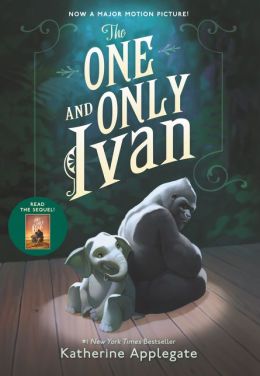- Newbery Award Winner
- Illustrated by Patricia Castelao Costa
- 305 pages
The best thing about The One and Only Ivan is that once you've finished it, once you've cried and cheered and rooted for Ivan for 305 pages, you find out that it's true. You learn that there was actually a silverback named Ivan who lived in solitary captivity in Washington state until public outcry and pressure led to his being sent on "permanent loan" to Zoo Atlanta, where he lived to the age of 50. You learn that he was known for his paintings. You begin to wish that this book had come out just a few years earlier so that after you read it you would still have the chance to visit Ivan. To maybe purchase one of his pictures.
And that's when it starts to hit you. If there really was a silverback named Ivan whose life took the general trajectory of the titular character in Katherine Applegate's novel, then it's not just the good parts that are true, it's all of the hideousness and pain that came before them as well. It's little Ivan being ripped away from his parents. It's Tag dying en route to America. It's a mighty silverback gorilla living, alone, for twenty-seven years without seeing any others of his kind.
And didn't you- in your elation over his existence and your wish that you could visit him- didn't you just represent the very culture that allowed these things to occur?
The power of Applegate's novel lies not simply in how relatable she makes Ivan, but in the questions she forces us to face in ourselves. One way she does this is by making his captor frighteningly relatable. It's easy to read the scene in which Mack goads Ruby with the claw-stick and think, "How terrible, I would never stand around and allow that to happen!" It's less easy to say that about the scenes of Ivan growing up in Mack's house.
"It was Mack who pried open that crate, Mack who bought me, and Mack who raised me like a human baby."
- The One and Only Ivan, page 130
Ivan wears diapers, drinks from a bottle, sleeps in human beds, and is even taken to dinner with Mack and his wife. He is not abused or left in a cage alone, and really, the image of a baby gorilla in a diaper is so adorable- can it really be such a bad thing? Would we really react to it as animal cruelty if we saw it on the street? The hard answer is that unfortunately, most of us would not.
Despite the how relatable these scenes are, Applegate never for a moment lets the reader forget why it is, indeed, pure selfishness and cruelty:
"One day, after many weeks of loud talking, Helen packed a bag and slammed the front door and never came back.
I don't know why. I never know the why of humans.
That night, I slept with Mack in his bed.
My old nests were woven of leaves and sticks and shaped like his bathtub, cool green cocoons.
Mack's bed, like mine, was flat, hot, without sticks or stars."
- The One and Only Ivan, page 141
Though Mack does not physically abuse Ivan, he tries to treat him as though he is human, and in doing so denies the very fact that Ivan is a gorilla. This complete removal of everything that makes Ivan a gorilla is itself abuse. Gorillas are not pets, and there is no in-between about it: keeping a gorilla as a pet is just as wrong as turning a gorilla into a roadside attraction.
Here, Bob the mutt serves as an interesting contrast to Ivan's situation. Unlike Ivan, who was born and (initially) raised a wild animal before falling into human captivity, Applegate implies that Bob was the product of a different type of human cruelty altogether: overbreeding and indifference.
"Bob used to have three brothers and two sisters. Humans tossed them out of a truck and onto the freeway when they were a few weeks old. Bob rolled into a ditch.
The others did not."
- The One and Only Ivan, page 35
Bob, the product of dogs bred as house dogs even if he himself is not one, can barely scrape by on his own, in this human world into which he was tossed to die. He is not a wild animal, he is a natural and deliberately bred human companion. Thus, the fact that he ends the novel living with Julia is more than just a happy ending, it's where he should be, where (like Ivan at Zoo Atlanta) he is most likely to thrive.
And yet, still, there is something unsatisfying in both of their stories. Because really, we don't want Ivan at Zoo Atlanta, we want him to have never been ripped from his family in the Democratic Republic of the Congo. We don't want Bob to have come to Julia the way he did; we wish that he and all of his brothers and sisters could be living with her. But are either of those things even possible in today's world? Or are zoos and loving people who show up after the fact the best we can hope for?
It is these complicated and emotional questions that make The One and Only Ivan such a powerful story, particularly for children. Because, of course, the answer is that if human attitude towards and treatment of animals is going to change, it has to begin with the children.
Below is a video of the real Ivan, released by Zoo Atlanta after his passing in 2012:

No comments:
Post a Comment